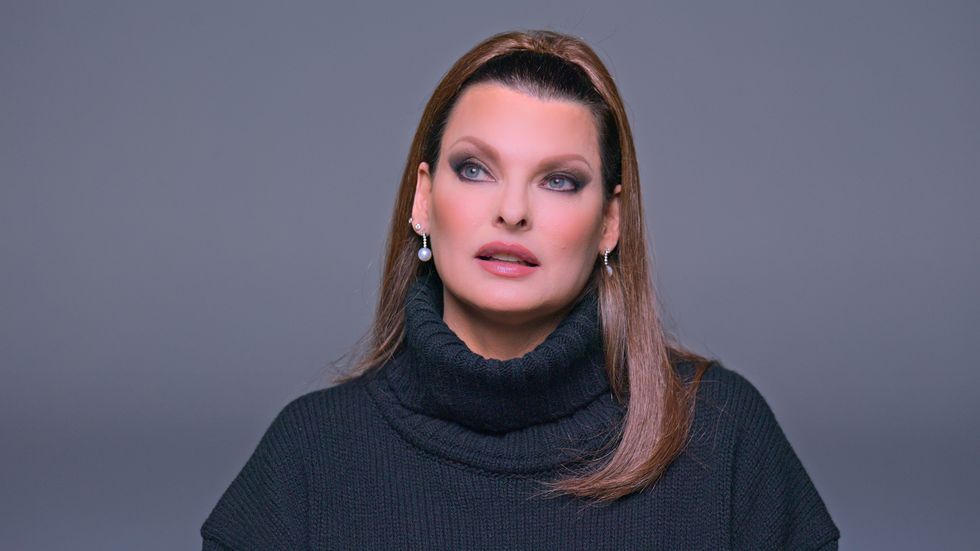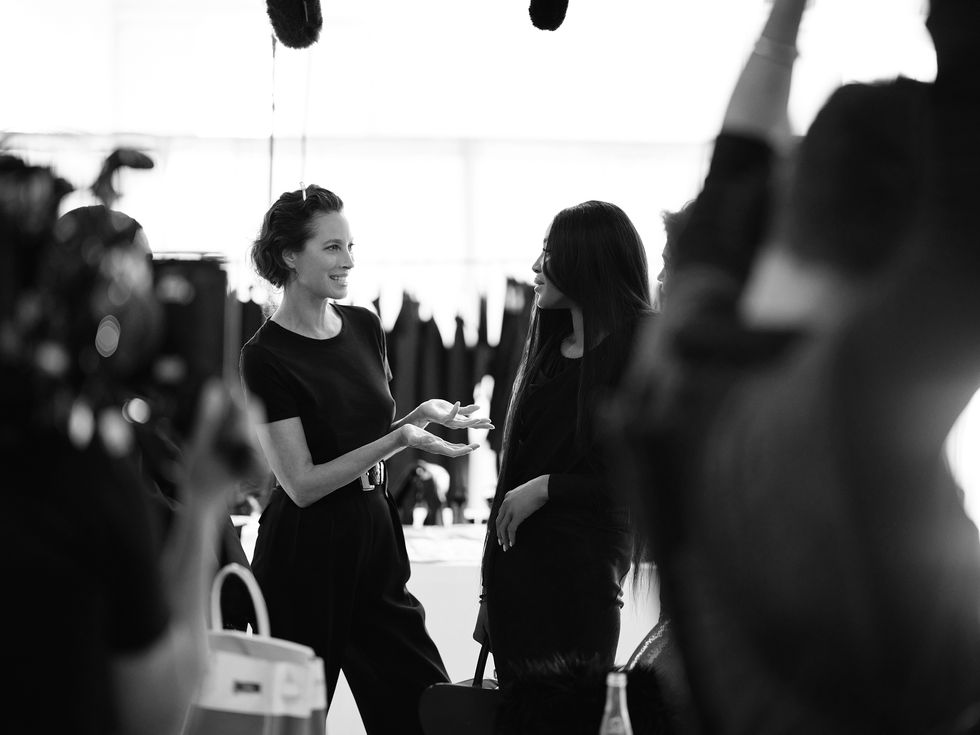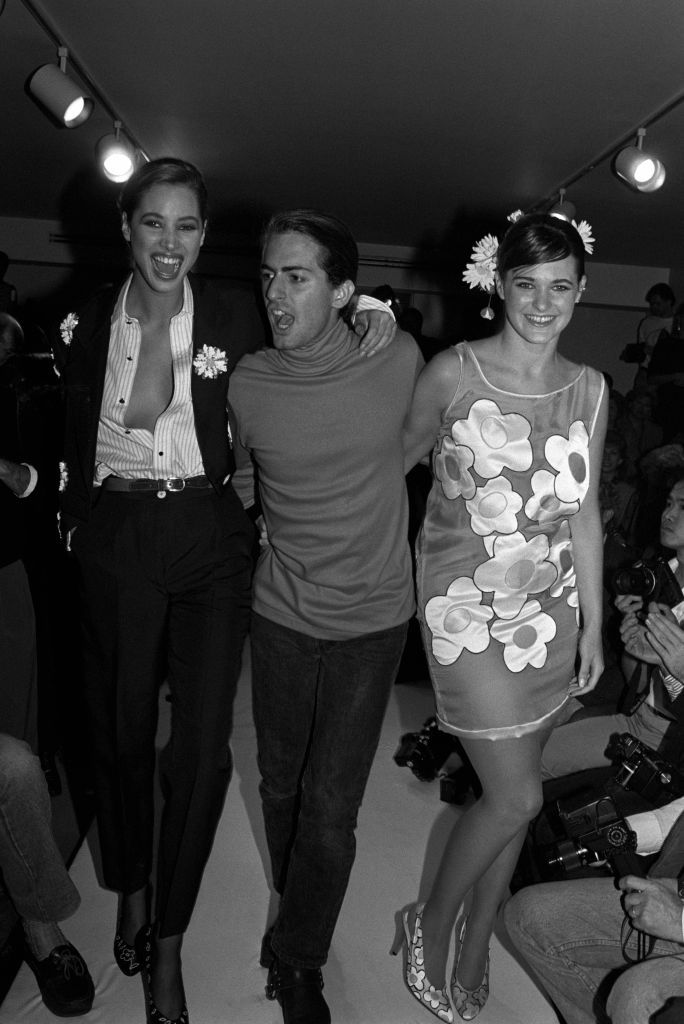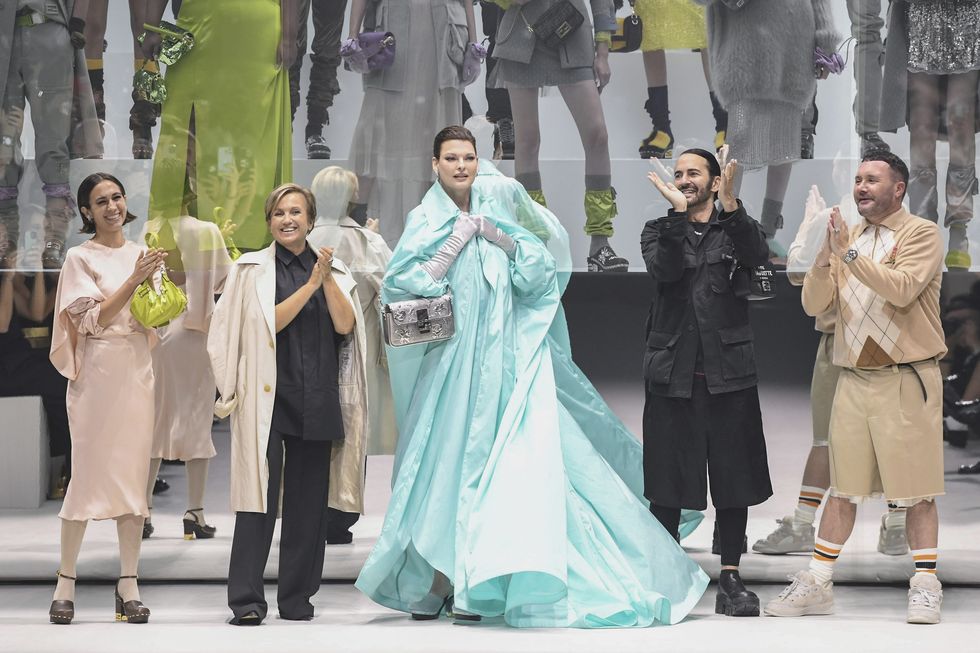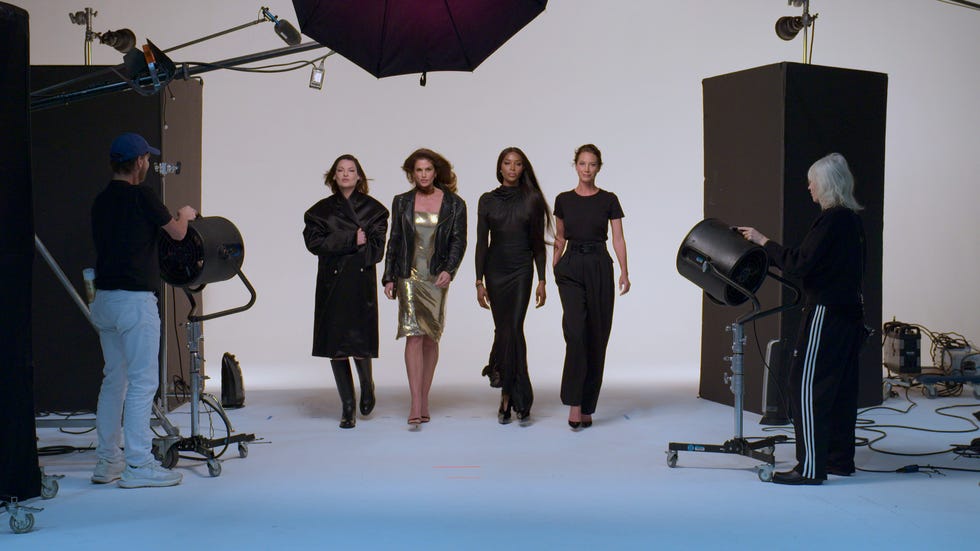10 Things We Learned from the The Super Models Docuseries
This story contains references to sexual assault and abuse. If you or someone you know needs support, contact the National Sexual Assault Hotline at 800-656-HOPE (4673) or visit rainn.org.
Spoilers below.
Naomi Campbell, Linda Evangelista, Christy Turlington, and Cindy Crawford have been everywhere since their fashion domination in the ’90s, from runways and magazine covers to red carpets and commercials. And now, they’re the subjects of a new documentary series. Aptly titled The Super Models, the four-part Apple TV+ series traces the stars’ illustrious careers, legacies, and impact on the fashion world and pop culture at large.
Directed by Roger Ross Williams and Larissas Bills and executive produced by the supermodels themselves, the project shows these titans of the industry not only at their peak but also in their humble beginnings and vulnerable moments. Through their stories, the series addresses larger cultural conversations like abuse in the modeling industry, impossible beauty standards, and shifting views on aging. And of course, it highlights the icons’ lasting friendship.
Here are some takeaways.
Linda Evangelista reveals she was in an “abusive relationship.”
Evangelista was married to Gérald Marie, an executive at Elite Modeling Agency, from 1987 to 1993; at the start of their marriage, she was 22 years old. “It’s easier said than done to leave an abusive relationship. I understand that concept because I lived it,” she said in the series. “If it was a matter of just saying ‘I want a divorce, see ya,’ it doesn’t work that way.”
She didn’t divulge specific details, but said, with her voice breaking, “He knew not to touch my face, not to touch the money-maker, you know?”
Evangelista said that eventually, Marie “let me out” of the relationship “as long as he got everything. But I was safe, and I got my freedom.”
Marie’s lawyer Céline Bekerman responded to Evangelista’s account in a statement to People this week: “Gérald Marie firmly objects to the defamatory and false allegations made against him. He refuses to participate in this dishonest media controversy.”
Several women have come forward and accused Marie of sexual assault, which he denied. When Evangelista learned that her ex-husband had hurt and “violated” other women, “it broke my heart,” she said in the doc. But it emboldened her to open up too.
“I never, never told my story, because I feared,” she said. “Thanks to the power of all these women coming forward—bless them, God bless all of them—it gave me the courage, now, to speak.”
In February 2023, French prosecutors closed an investigation into alleged rapes and sexual assaults by Marie due to the statute of limitations for public action. In a statement that appears in the docuseries, his lawyer says Marie denies claims of abuse and said he “has never committed the slightest act of violence.”
As for her feelings on Marie today, Evangelista said, “I would love that justice be served. I would love for assholes like that to think twice and be afraid. And I would love for women to know that they’re not alone.”
The group weighs in on abuse of power in the industry.
It wasn’t just Evangelista; the rest of the models also spoke about the prevalence of sexual misconduct and predators in the modeling world.
Turlington was represented by Ford Models, which had previously partnered with Karin Models Agency, which was led by Jean-Luc Brunel. He had links to Jeffrey Epstein and was charged with sexual harassment and rape of at least one minor over the age of 15 in 2020, per NBC News. He died by suicide in his jail cell in February 2022.
In the doc, Turlington recalled that when she would go to Paris to work, Ford arranged for her to stay at Brunel’s apartment. “Nothing happened,” she clarified. “Most of the time he wasn’t even there.” Later on, after the allegations about Brunel came to light, she “got angry just looking back” at her proximity to him. “I can’t believe that I’m okay.”
She added, “Nothing really surprises me about anybody. I feel like even people you know, you just don’t know what they’re capable of.”
“I think most of us are young,” Crawford said of models who are just starting out and vulnerable to people in power. “You’re put in an environment that is completely new to you.”
“You’re overpowered by an older man who’s going to guide your career, you trust him,” added Campbell. “You know, same old story.”
But the group was also able to find support in their mentors and friends, such as Steven Meisel or Gianni Versace. Campbell, for example, recalls her father-daughter relationship with the late Azzedine Alaïa. The esteemed designer took a young Campbell under his wing, and she lived with him with her mother’s permission. They were like family—she still calls him Papa—and he acted as her guardian. “Once, an art director felt the need to tell me that he thought my breasts were perfect, that he felt the need to have to touch them,” Campbell said. “I called Papa immediately. I called Papa right away, and Papa called him up and read him. Never came near me again.”
They talk about what it was like being photographed nude.
Evangelista remembered going to Japan as a teen for an early modeling job, which took a dark turn. “When I got to Japan, [the] first thing they asked me was about nude photographs, and they wanted to take all my measurements and ‘take your clothes off.’ And I’m like, I just made a composite [card], and it had my measurements on it. And I didn’t want to take my clothes off. I kind of freaked out. I never should’ve went there by myself. I went home.”
But nudity didn’t necessarily mean powerlessness if the model agreed with the concept and felt supported on set. That was a lot different from, say, getting snapped by paparazzi while getting undressed backstage after a runway show, which they touch upon later in the series.
Crawford, for example, chose to pose for Playboy, because it was exciting and different for her career, even if her agency pushed back against it. In fact, she took the photos during the same shoot she did with Herb Ritts for French Vogue, so they looked stylistically similar—still revealing and provocative, but more refined. Crawford said that it might have been a controversial gig, but “if they’re my decisions, and I have control of it, that’s empowering to me. Even if it’s doing Playboy. I never felt like a victim of that decision.”
“I don’t feel like when I’m nude that I’m nude. It really depends on who I’m shooting for. I could feel like I’m totally clothed,” Campbell said. “It’s the concept and the way when it’s tastefully done, I don’t feel like I’m nude.”
“If I’m working with somebody that I trust and that I have respect for and I understand their vision, then I can take some risks,” Turlington said.
They of course referenced the famous nude portraits by Ritts featuring Crawford, Campbell, Turlington, and fellow models Stephanie Seymour and Tatjana Patitz. “We were naked, but we weren’t being sexy; there was a simplicity to being without clothes,” Crawford said of the now-iconic group shot.
They helped put younger designers on the map.
Campbell, Crawford, Turlington, and Evangelista’s presence at runway shows would garner so much press attention that designers were dying to cast them to create buzz around their brands. (After falling at a Vivienne Westwood show, Campbell even remembered designers asking her to fall on their catwalks just to generate press.) But some of the newer designers couldn’t afford to put a supermodel in their roster, including Marc Jacobs in his early years.
He would ask agencies if any models would work for free clothes, and Turlington did. “And then the next season when we did a show, Christy asked Cindy, then there was Naomi, then there was Linda,” Jacobs said in the doc. “The attention just kind of grew and grew and grew and grew, but it was all because of Christy.”
Anna Sui and Isaac Mizrahi had similar stories.
Evangelista opens up about her CoolSculpting side effects and cancer diagnosis.
Evangelista first went public with her health issues resulting from a CoolSculpting procedure in a 2022 cover story with People magazine. In the doc, she further elaborates on why she took the treatment in the first place and how she handled the rare adverse effects on her body.
“I can’t like myself with these hard masses and protrusions sticking out of my body,” she said.
She explained that she fell into a “deep depression” following the side effects, which led to “years of hiding.” She rarely left the house, except for doctor’s appointments. She hadn’t worked in years, which left her “heartbroken.” “I loved my job,” she said.
Evangelista thinks scars are like “trophies,” but the physical damage of CoolSculpting, like protrusions on her body that she couldn’t remove, was different. “To be disfigured is not a trophy,” she said.
“I wish we could just really see ourselves in the mirror, non-distorted, without ever having seen ourselves with a filter or retouched,” she reflected. She added that, at times after the procedure, she felt “trapped with yourself that you hate.”
In a 2022 Rolling Stone report, a rep for CoolSculpting said: “CoolSculpting has been well studied with more than 100 scientific publications and more than 11 million treatments performed worldwide. Rare reported side effects can include paradoxical hyperplasia, severe pain or late-onset pain, and continue to be well-documented in the CoolSculpting information for patients and health care providers and sample consent form given to health care providers to use with patients.”
In July 2022, Evangelista stated that she and CoolSculpting’s parent company settled a lawsuit, which she filed concerning her procedures, for an undisclosed amount.
In The Super Models, Evangelista opened up further about other health issues: She was diagnosed with breast cancer over three years ago, and she chose to have a double mastectomy, but the illness came back. Footage in the doc shows her in ongoing treatment. She’d also had Birt-Hogg-Dubé syndrome that would cause her lung to collapse, leading her to undergo multiple surgeries.
After coming forward with her health scare, Kim Jones invited her to close the Fendi show in September 2022. It was Evangelista’s first runway appearance in 15 years.
Naomi Campbell speaks about the racism she felt in the industry.
“What the white model was getting, I wanted it too,” Campbell said in the series. But she faced more barriers to success than her white counterparts.
Before Campbell left England for the U.S. to pursue her career, her mother warned her about racism in America. “I started to understand, culturally, that I was gonna have to work really hard to feel accepted,” she recalled.
“Naomi wasn’t always booked to do the shows,” Evangelista said. At the time, she “didn’t understand” why. “Naomi, I thought, was more beautiful, had a much more rockin’ body than I did and a better strut, and I’m like, why aren’t they booking her?” she said. So, she and her friends responded with collective action. “I said to them, if you don’t book her, you don’t get me,” Evangelista said.
Campbell confirmed: “Linda and Christy absolutely put themselves on the line. They stood by me, and they supported me. And that’s what kept me going.”
The British model remembered that after getting booked on runways, ad campaigns then posed their own challenges. Sometimes she wouldn’t be included “and that used to really hurt me.” There were other times she was hired simply to “appease” her. “Then I’d go to the shoot and sit there from nine to six all day and not be used,” she said. “It made me more determined than ever.”
She also reflects on being labeled as “difficult.”
“It was hard to be an outspoken Black woman, and I definitely got the cane for it many times,” Campbell said. One of those instances was when she was working with modeling agent John Casablancas (who died in 2013) on a potential deal with Revlon, which she turned down once she learned she’d be making significantly less than her counterparts. Campbell said when she left Casablancas’ agency, he then went to the media, portraying her as difficult.
Campbell also reflected on how the assassination of Gianni Versace, a close friend, in 1997 led her to turn to drugs to “cover up” the pain. “Addiction is such…it’s just a bullshit thing. You think it’s going to heal that wound. It doesn’t.” Instead, it brought about fear and anxiety, and she “got really angry,” alluding to her past assault charges.
As for her feelings of abandonment, “I tried to cover that with something,” Campbell said. “You can’t cover it. I was killing myself.”
“My mistakes, I’ve always owned up to them,” she added. She chose to go to rehab, which was “one of the best and only things I could’ve done for myself at that time.”
She also paid it forward; friends Marc Jacobs and John Galliano attested in the doc to Campbell’s support when they were struggling with partying or drug abuse, respectively.
They acknowledge the impact of gay culture.
The ballroom scene and queer community were inspired by the high fashion world, but the influence went both ways, the models say.
“I really believe gay culture and the drag community helped me flourish,” Evangelista said. “Because they’re larger than life. They’re like what I want to be, but bigger. Bigger and better. And with confidence.”
She gave props to RuPaul and said getting name-dropped in his song “Supermodel (You Better Work)” is a “major honor.”
After all, their collaboration with George Michael, a trailblazing gay pop star and LGBTQ+ advocate, marked a major change in their career. He invited them to appear in his “Freedom! ’90” music video, which launched them not only into fashion stardom but also pop culture stardom.
This content is imported from youTube. You may be able to find the same content in another format, or you may be able to find more information, at their web site.
The group also discusses beauty standards and aging.
The crew, who are all in their 50s today, opened up about aging in the modeling industry, which they started working in as literal teenagers. “So many barriers have been taken down since I started modeling,” Evangelista said. “Age was one of them.”
“They used to say beauty’s not sustainable. Youth is not sustainable; beauty is,” Evangelista later added. “There’s a difference.”
In one BTS clip, Campbell laughs off having hot flashes mid-photoshoot. She said at times she’s thought about slowing down or pulling back on her modeling career, but her “energy is still the same.”
Crawford also briefly acknowledged that the beauty standards she and her peers embodied, especially at the height of their careers, weren’t very accessible or inclusive. They were “the physical representations of power,” she said. “And where it gets tricky and hard to talk about is that some people don’t fit that, and then they’re made to feel less beautiful.”
As social media continues to democratize fashion and help uplift more diverse beauty standards, Crawford wondered, “Maybe the idea of what a model is and represents now has picked up steam, and maybe that’s a great thing…” She added, “There’s all these different ideas of beauty now. And all of the sudden that is creating its own stars, its own momentum, its own energy, and its own ideas.”
They’ve found fulfillment beyond modeling.
Decades into their careers, Campbell, Crawford, Evangelista, and Turlington have achieved so much beyond the runways, through motherhood, philanthropy, and their own businesses.
“Becoming a mom, that’s the most fulfilling thing that’s happened to me,” Evangelista said of her 16-year-old son.
For Turlington, fronting anti-smoking campaigns and supporting maternal health; for Campbell, supporting burgeoning designers, especially those from Africa; and for Crawford, her business endeavors—from skincare to furniture—and mentoring her two model kids, Presley and Kaia Gerber.
Turlington said that their longevity is “the opposite” of what she imagined her career would be like in the industry when she first started.
Watch The Super Models on Apple TV+
Erica Gonzales is the Senior Culture Editor at ELLE.com, where she oversees coverage on TV, movies, music, books, and more. She was previously an editor at HarpersBAZAAR.com. There is a 75 percent chance she’s listening to Lorde right now.


